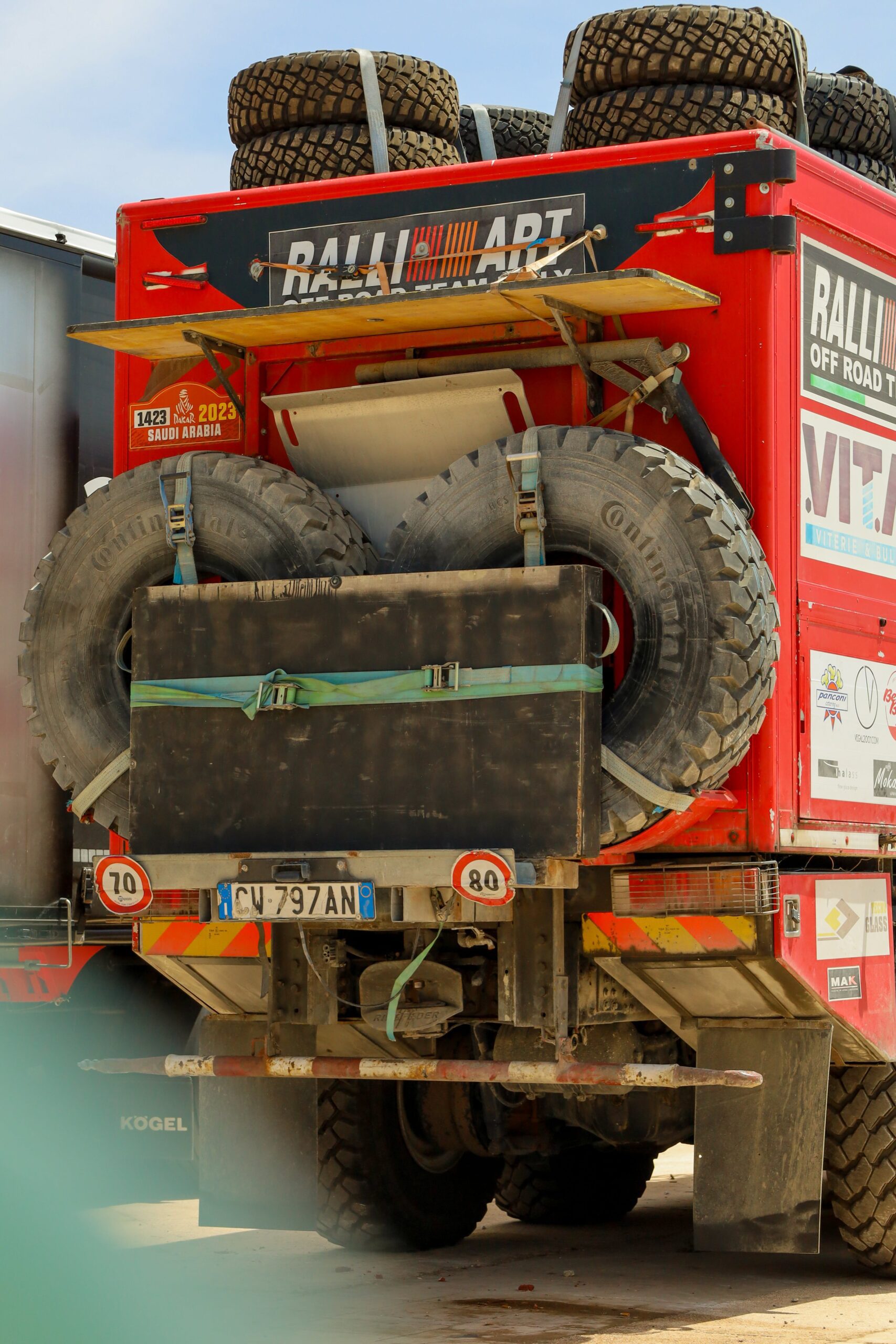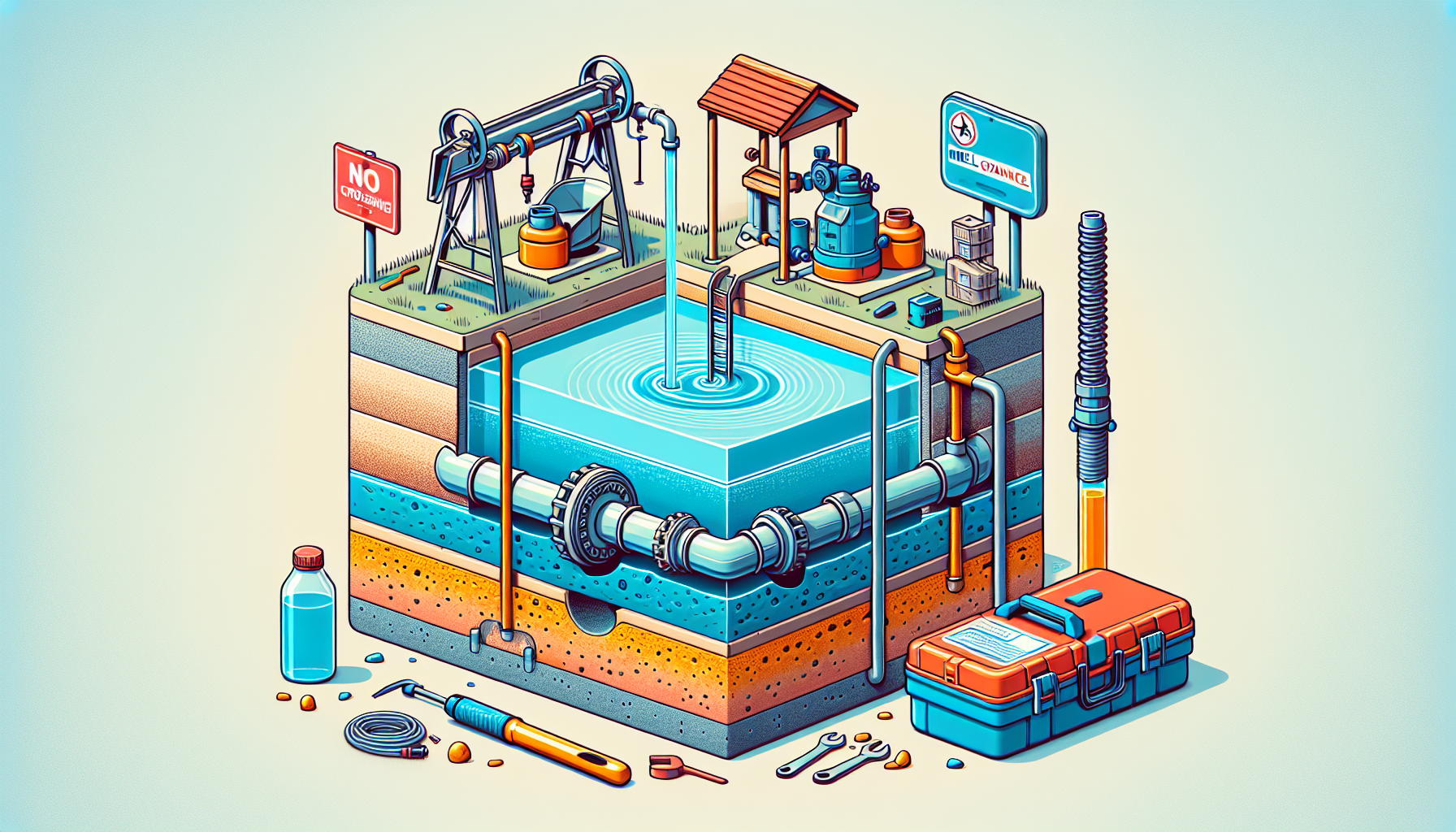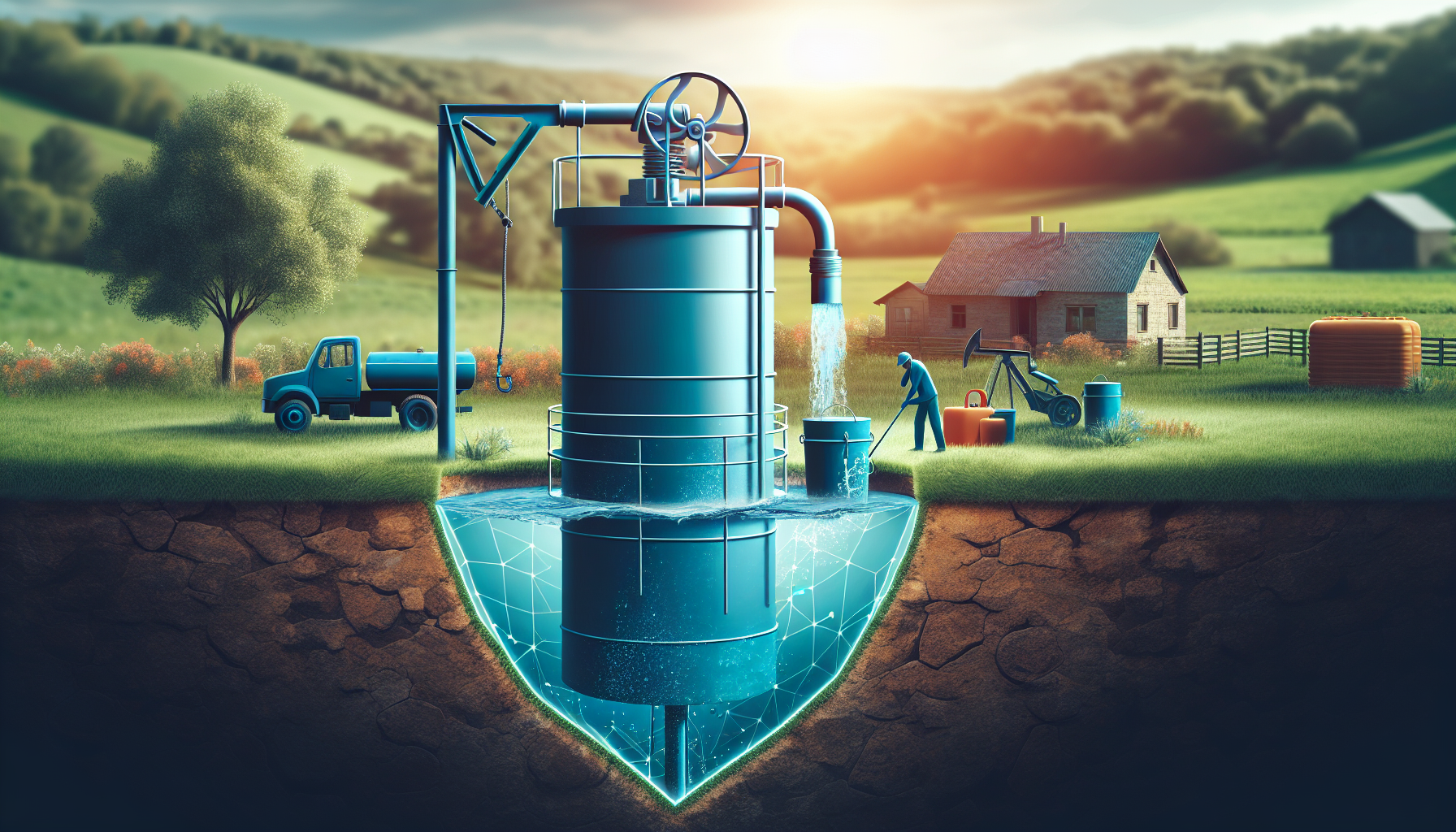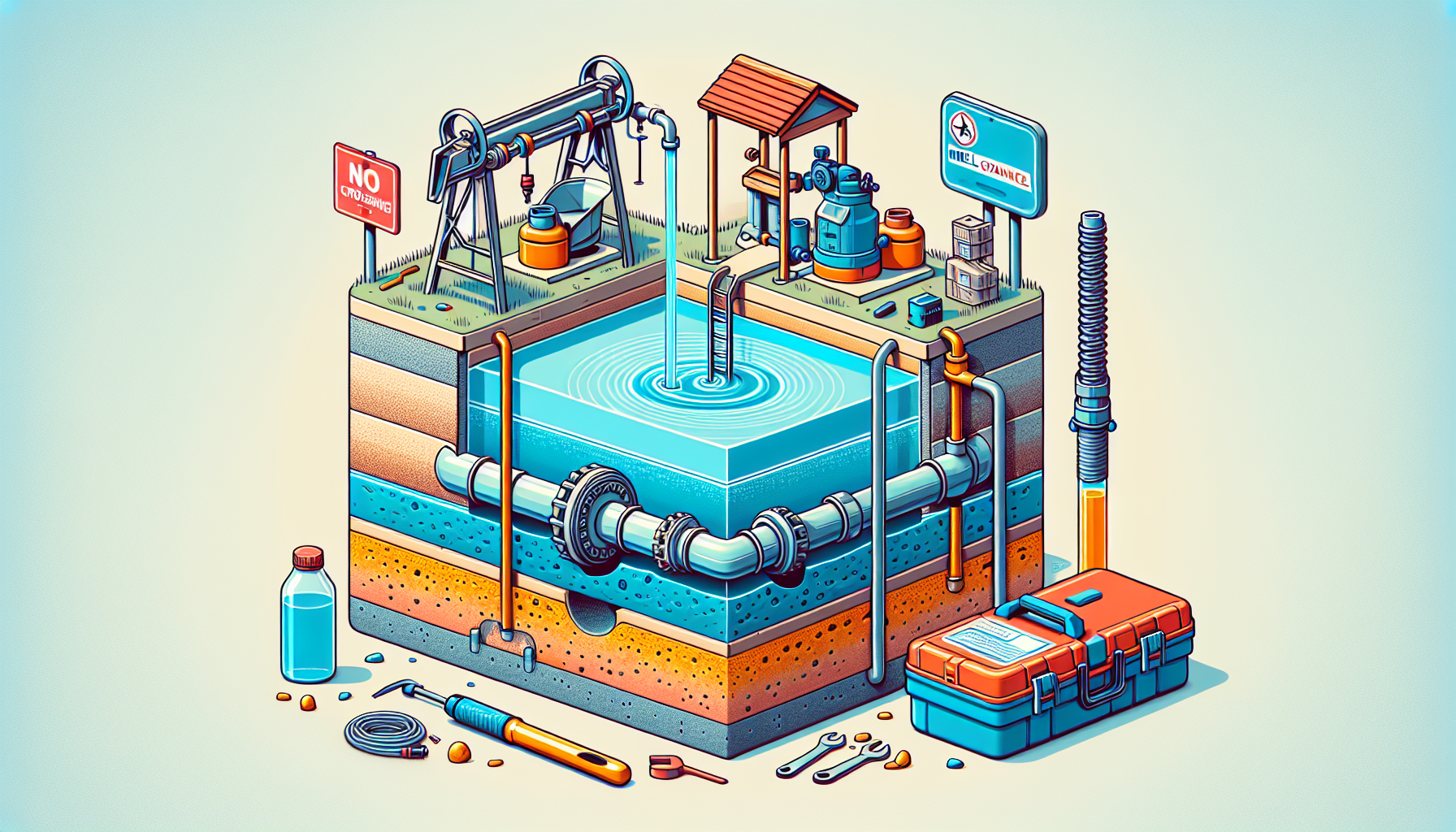In this article, you will discover how to effectively address safety concerns when it comes to well water in areas with well water pressure tank maintenance requirements. We will explore the necessary steps you can take to ensure the safety and quality of your well water, providing you with peace of mind and a healthy water supply for you and your family. By understanding the importance of regular maintenance and taking appropriate precautions, you can confidently tackle any safety concerns related to well water. So let’s dive into the details and find out how you can maintain a safe and reliable water source.

Importance of Well Water Safety
Well water is a valuable resource that can provide clean and fresh water for your household. However, it is essential to understand the potential risks associated with well water and take necessary measures to ensure its safety. When it comes to well water safety, several factors need to be considered, including the understanding of risks, the effects of contaminated well water, the need for proper maintenance, and more. By prioritizing well water safety, you can protect the health and wellbeing of you and your loved ones.
Understanding the Risks
To effectively address safety concerns related to well water, it is crucial to have a comprehensive understanding of the potential risks involved. Well water can be contaminated by various factors, such as surface runoff, agricultural activities, septic systems, and industrial pollutants. Understanding the potential sources of contamination will help you identify the necessary precautions to take and further prevent any health risks associated with consuming contaminated well water.
Effects of Contaminated Well Water
The consumption of contaminated well water can have severe health effects on individuals. Bacterial contamination, such as E. coli, can cause gastrointestinal illnesses, leading to symptoms like nausea, vomiting, and diarrhea. Moreover, chemical contaminants, including pesticides and heavy metals, can pose long-term health risks, such as organ damage, developmental issues, and even cancer. Recognizing the potential effects of contaminated well water highlights the importance of maintaining its safety and implementing preventive measures.
The Need for Proper Maintenance
Proper maintenance of your well water system is crucial to ensure the safety and quality of the water supply. Regular maintenance helps identify any potential issues, such as leaks, rust, and bacterial contamination, before they lead to more significant problems. By addressing maintenance requirements promptly, you can prevent contamination incidents and maintain the optimal performance of your well water system. Now, let’s delve deeper into the specifics of well water pressure tank maintenance to understand its significance in ensuring well water safety.
Well Water Pressure Tank Maintenance
The pressure tank is a vital component of your well water system, responsible for regulating water pressure and ensuring a steady supply of water. To maintain the safety and efficiency of your well water system, it is essential to perform regular maintenance on the pressure tank. Here are some key steps to consider:
Inspecting the Pressure Tank
Regular inspection of the pressure tank is crucial to identify any potential issues. Look for signs of corrosion, cracks, or leaks in the tank itself and its fittings. Additionally, ensure that the pressure switch, pressure relief valve, and pressure gauge are functioning correctly. Any abnormalities should be addressed promptly to prevent potential risks.
Checking for Leaks
Even small leaks in the pressure tank can lead to significant problems over time. Regularly check for any signs of leakage, such as water stains or wet spots around the tank or fittings. If you notice any leaks, it is essential to repair or replace the affected components promptly to prevent further damage and maintain the safety of your well water system.
Cleaning and Disinfecting
Cleaning and disinfecting the pressure tank is another crucial aspect of maintenance. Over time, sediment and bacteria can accumulate inside the tank, potentially compromising the quality of your well water. Periodically cleaning and disinfecting the tank will remove any build-up and ensure that your water remains safe to drink.
Maintaining Proper Water Levels
Maintaining proper water levels in the pressure tank is essential for its optimal performance. Insufficient water levels can cause the pump to overwork and lead to premature wear and tear. Regularly check the water levels in the tank and adjust them as necessary using the pressure switch or valve. This will help extend the lifespan of your well water system and maintain its safety.
Addressing Rust and Corrosion
Rust and corrosion can significantly affect the integrity and performance of the pressure tank. Regularly inspect the tank for any signs of rust or corrosion, especially in metal components and fittings. If you notice any issues, it is important to address them promptly by cleaning the affected areas, applying rust inhibitors, or replacing the damaged parts. By preventing rust and corrosion, you can ensure the long-term safety and functionality of your well water system.
Identifying Safety Concerns
Identifying safety concerns related to your well water is a crucial step in maintaining its safety. By regularly testing the well water quality and monitoring changes in water characteristics, you can detect any potential contamination or issues that require attention. Here are some key steps in identifying safety concerns:
Testing Well Water Quality
Regular testing of your well water is essential to ensure its safety and quality. This testing should include analysis for bacteria, such as E. coli, as well as chemical contaminants like pesticides, nitrates, and heavy metals. By testing your well water, you can identify any potential risks and take appropriate measures to address them.
Detecting Bacterial Contamination
Bacterial contamination is a common concern in well water systems. Testing for bacteria is crucial, as it helps identify any potential risks to your health. If bacterial contamination is detected, it is important to implement proper treatment methods to eliminate harmful bacteria and ensure the safety of your drinking water.
Identifying Chemical Contaminants
Chemical contaminants, such as pesticides and industrial pollutants, can pose significant health risks if present in your well water. Regular testing for chemical contaminants will help you identify the presence of any harmful substances and take necessary actions to treat and prevent further contamination.
Monitoring Changes in Water Characteristics
Regular monitoring of changes in water characteristics is essential in identifying safety concerns related to your well water. Pay attention to any changes in color, odor, taste, or clarity of the water. These changes may indicate the presence of contaminants or other issues that require immediate attention. By staying vigilant and monitoring water characteristics, you can address safety concerns promptly and maintain the quality of your well water.
Ensuring Safe Drinking Water
Ensuring safe drinking water from your well requires a proactive approach that involves regular testing, proper treatment methods, and the implementation of appropriate water treatment systems. By following these steps, you can have peace of mind knowing that your well water is safe to drink. Here are some key measures to consider:
Regular Water Testing
Regular water testing should be a priority when it comes to ensuring the safety of your drinking water. Schedule routine tests with certified laboratories to analyze for bacteria, chemicals, and other contaminants. Additionally, consider testing after any significant changes in your well water system or if you suspect any potential issues.
Treating Bacterial Contamination
If bacterial contamination is detected in your well water, it is essential to implement proper treatment methods. Chlorination is a commonly used method to disinfect well water and eliminate harmful bacteria. Follow the recommended guidelines for chlorination or consult a water treatment professional to ensure effective treatment.
Filtering Chemical Contaminants
Filtering systems can effectively remove chemical contaminants from your well water. Consider installing appropriate filters that target specific contaminants based on your water test results. Activated carbon filters, reverse osmosis systems, and distillation units are among the options available for treating chemical contaminants.
Implementing Water Treatment Systems
Water treatment systems, such as UV disinfection and water softeners, can further enhance the safety and quality of your well water. UV disinfection uses ultraviolet light to kill bacteria and other microorganisms, making the water safe to drink. Water softeners can remove minerals that cause hardness, improving the taste and preventing plumbing issues.
Considering UV Disinfection
UV disinfection is an effective method for treating well water and eliminating harmful bacteria and microorganisms. UV disinfection systems expose the water to UV light that deactivates the DNA of bacteria, rendering them harmless. Consider installing a UV disinfection system in your well water system to ensure safe drinking water.

Proper Well Water System Design
Proper well water system design is crucial in ensuring the efficient and safe operation of your water supply. Determining water usage needs, sizing the pressure tank correctly, choosing appropriate filters, and installing backflow prevention devices are key considerations in the design process.
Determining Water Usage Needs
Understand your household’s water usage needs to ensure that your well water system is designed to meet the demand. Consider the number of occupants, daily water usage, and any specific water-intensive activities. Properly sizing the well and pressure tank will ensure a consistent and sufficient water supply.
Sizing the Pressure Tank
The pressure tank should be sized appropriately to accommodate the water demand of your household. An undersized tank may result in inadequate water pressure, while an oversized tank can lead to short cycling and decreased efficiency. Consult a water well contractor to determine the optimal size for your pressure tank based on your water usage needs.
Choosing Appropriate Filters
Selecting appropriate filters is important in maintaining the safety and quality of your well water. Based on your water test results, choose filters that target specific contaminants or opt for a multi-stage filtration system that addresses multiple concerns. Ensure that the filters are compatible with your well water system and consider regular maintenance and replacement to optimize their functionality.
Installing Backflow Prevention Devices
Backflow prevention devices are essential in preventing potential contamination incidents in your well water system. These devices ensure that water flows in one direction, preventing the backflow of contaminants from entering your water supply. Proper installation and annual testing of backflow prevention devices will help safeguard your well water system and maintain its safety.
Maintaining Water Well Infrastructure
Maintaining the infrastructure of your water well is crucial in ensuring its longevity and continued safe operation. Regular inspection, repair of cracks and leaks, replacement of worn-out components, and protection against freezing are key aspects of water well infrastructure maintenance.
Well and Pump Inspection
Regular inspection of your well and pump is essential in identifying any potential issues or damage. Inspect the well for signs of cracks, leaks, or structural damage. Additionally, check the pump for proper functioning and any signs of wear and tear. If any problems are detected, consult a water well contractor for necessary repairs or replacements.
Repairing Cracks and Leaks
Cracks and leaks in the well structure or piping can lead to contamination and affect the efficiency of your well water system. Promptly repair any cracks or leaks to prevent further damage and maintain the safety of your water supply. Consult a water well contractor for professional repairs and ensure that the materials used are appropriate for your well infrastructure.
Replacing Worn-out Components
Components such as pipes, fittings, pressure switches, and valves can wear out over time and affect the functionality of your well water system. Regularly inspect these components and replace any worn-out parts to ensure the optimal performance and safety of your well water system. Use high-quality materials and consult a water well contractor for guidance if needed.
Protecting Against Freezing
Freezing temperatures can cause damage to your well water system, leading to cracks, leaks, and other issues. Protecting against freezing involves insulating the well, pipes, and pressure tank to prevent exposure to extreme temperatures. Additionally, consider installing a well house or heat tape to further protect the infrastructure. By addressing freezing concerns, you can ensure the safety and functionality of your well water system.

Educating Well Water Users
Educating well water users is essential in promoting well water safety and fostering responsible water usage practices. By understanding well water safety, being aware of contamination sources, emphasizing the importance of regular testing, and implementing safe water usage practices, you can contribute to the overall safety and quality of your well water.
Understanding Well Water Safety
Educate yourself and your household members about the importance of well water safety. Familiarize yourself with potential risks and ways to maintain the safety of your well water. Understanding the basics of well water safety will enable you to make informed decisions regarding maintenance, testing, and treatment.
Awareness of Contamination Sources
Being aware of contamination sources will help you take preventive measures to protect your well water. Educate yourself about potential contaminants, such as agricultural chemicals, septic systems, and industrial pollutants, and their impact on water quality. Implement necessary precautions, such as maintaining a safe distance between potential contamination sources and your well.
Importance of Regular Testing
Regular testing is crucial in ensuring the safety of your well water. Educate yourself and your household members about the importance of regular testing and the types of contaminants that should be tested for. Encourage everyone to participate in the testing process and emphasize its significance in maintaining the quality of your drinking water.
Safe Water Usage Practices
Promote safe water usage practices among well water users. Educate yourself and your household members about efficient water use, such as avoiding excessive water consumption, fixing leaks promptly, and using water-saving appliances. By practicing responsible water usage, you can not only conserve water but also reduce the strain on your well water system and ensure its long-term safety.
Emergency Response and Preparedness
Emergency response and preparedness are essential in addressing contamination incidents and ensuring the safety of your well water. By creating emergency action plans, knowing well shut-off procedures, storing emergency water supplies, and addressing contamination incidents promptly, you can effectively respond to emergencies and protect your well water.
Creating Emergency Action Plans
Create an emergency action plan specific to your well water system. This plan should include steps to follow in case of contamination incidents, equipment failures, or other emergencies. Assign responsibilities to household members, establish communication protocols, and ensure that necessary supplies and contact information are readily available.
Knowing Well Shut-off Procedures
Knowing how to shut off your well water system is crucial in preventing the spread of contamination in case of emergencies. Educate yourself and your household members about the well shut-off procedures and regularly practice them to ensure everyone is familiar with the process. Additionally, make sure the shut-off valve is easily accessible and in good working condition.
Storing Emergency Water Supplies
In case of emergencies that affect your well water system, it is essential to have emergency water supplies readily available. Store an adequate amount of clean water in containers that are specifically designed for long-term water storage. This will provide you with a temporary water source until the issue with your well water system is resolved.
Addressing Contamination Incidents
In the event of a contamination incident, it is crucial to address it promptly to minimize risks and ensure the safety of your well water. Follow the guidelines provided by health agencies, contact water well contractors or certified laboratories for assistance, and implement necessary disinfection or treatment methods. Prompt response and appropriate actions will help mitigate the impact of contamination incidents on your well water system.

Collaborating with Professionals
Collaboration with water well contractors, health agencies, and certified laboratories is important in maintaining the safety of your well water. By seeking professional assistance, you can ensure that your well water system is properly maintained, tested, and treated. Here are some key considerations:
Consulting Water Well Contractors
Water well contractors have expertise in well water systems and can provide valuable guidance on maintenance, repairs, and upgrades. Consult a reputable water well contractor for regular inspections, repairs, and advice on improving the safety and efficiency of your well water system.
Seeking Assistance from Health Agencies
Local health agencies can provide valuable resources and assistance in addressing well water safety concerns. They can offer guidance on testing, treatment methods, and regulations related to well water. Stay informed about the services and recommendations provided by health agencies in your area to ensure the safety of your well water.
Working with Certified Laboratories
Certified laboratories play a crucial role in testing the quality of your well water. Collaborate with certified laboratories to schedule regular water tests, discuss results, and seek advice on appropriate treatment methods. Certified laboratories ensure accurate and reliable testing, helping you make informed decisions regarding the safety of your well water.
Conclusion
Prioritizing well water safety is of utmost importance to protect the health and wellbeing of you and your loved ones. By understanding the potential risks, effects of contaminated well water, and the need for proper maintenance, you can take proactive measures to maintain the safety and quality of your well water. From well water pressure tank maintenance to identifying safety concerns, ensuring safe drinking water, proper system design, infrastructure maintenance, education, emergency response, and collaboration with professionals, there are various aspects to consider when it comes to well water safety. By taking necessary precautions and staying vigilant, you can enjoy the benefits of clean and safe well water for years to come.


